2003 DODGE RAM height adjustment
[x] Cancel search: height adjustmentPage 230 of 2895

and cups will also have to be replaced after flush-
ing. Use clean brake fluid to flush the system.
(4) Check parking brake operation. Verify free
movement and full release of cables and pedal. Also
note if vehicle was being operated with parking
brake partially applied.
(5) Check brake pedal operation. Verify that pedal
does not bind and has adequate free play. If pedal
lacks free play, check pedal and power booster for
being loose or for bind condition. Do not road test
until condition is corrected.
(6) Check booster vacuum check valve and hose.
(7) If components checked appear OK, road test
the vehicle.
ROAD TESTING
(1) If complaint involved low brake pedal, pump
pedal and note if it comes back up to normal height.
(2) Check brake pedal response with transmission
in Neutral and engine running. Pedal should remain
firm under constant foot pressure.
(3) During road test, make normal and firm brake
stops in 25-40 mph range. Note faulty brake opera-
tion such as low pedal, hard pedal, fade, pedal pulsa-
tion, pull, grab, drag, noise, etc.
(4) Attempt to stop the vehicle with the parking
brake only and note grab, drag, noise, etc.
PEDAL FALLS AWAY
A brake pedal that falls away under steady foot
pressure is generally the result of a system leak. The
leak point could be at a brake line, fitting, hose, or
caliper/wheel cylinder. If leakage is severe, fluid will
be evident at or around the leaking component.
Internal leakage (seal by-pass) in the master cylin-
der caused by worn or damaged piston cups, may
also be the problem cause.
An internal leak in the ABS or RWAL system may
also be the problem with no physical evidence.
LOW PEDAL
If a low pedal is experienced, pump the pedal sev-
eral times. If the pedal comes back up worn linings,
rotors, drums, or rear brakes out of adjustment are
the most likely causes. The proper course of action is
to inspect and replace all worn component and make
the proper adjustments.
SPONGY PEDAL
A spongy pedal is most often caused by air in the
system. However, thin brake drums or substandard
brake lines and hoses can also cause a spongy pedal.
The proper course of action is to bleed the system,
and replace thin drums and substandard quality
brake hoses if suspected.HARD PEDAL OR HIGH PEDAL EFFORT
A hard pedal or high pedal effort may be due to
lining that is water soaked, contaminated, glazed, or
badly worn. The power booster or check valve could
also be faulty.
PEDAL PULSATION
Pedal pulsation is caused by components that are
loose, or beyond tolerance limits.
The primary cause of pulsation are disc brake
rotors with excessive lateral runout or thickness vari-
ation, or out of round brake drums. Other causes are
loose wheel bearings or calipers and worn, damaged
tires.
NOTE: Some pedal pulsation may be felt during
ABS activation.
BRAKE DRAG
Brake drag occurs when the lining is in constant
contact with the rotor or drum. Drag can occur at one
wheel, all wheels, fronts only, or rears only.
Drag is a product of incomplete brake shoe release.
Drag can be minor or severe enough to overheat the
linings, rotors and drums.
Minor drag will usually cause slight surface char-
ring of the lining. It can also generate hard spots in
rotors and drums from the overheat-cool down pro-
cess. In most cases, the rotors, drums, wheels and
tires are quite warm to the touch after the vehicle is
stopped.
Severe drag can char the brake lining all the way
through. It can also distort and score rotors and
drums to the point of replacement. The wheels, tires
and brake components will be extremely hot. In
severe cases, the lining may generate smoke as it
chars from overheating.
Common causes of brake drag are:
²Seized or improperly adjusted parking brake
cables.
²Loose/worn wheel bearing.
²Seized caliper or wheel cylinder piston.
²Caliper binding on corroded bushings or rusted
slide surfaces.
²Loose caliper mounting.
²Drum brake shoes binding on worn/damaged
support plates.
²Mis-assembled components.
²Long booster output rod.
If brake drag occurs at all wheels, the problem
may be related to a blocked master cylinder return
port, or faulty power booster (binds-does not release).
BRAKE FADE
Brake fade is usually a product of overheating
caused by brake drag. However, brake overheating
DRBRAKES - BASE 5 - 3
BRAKES - BASE (Continued)
Page 1278 of 2895
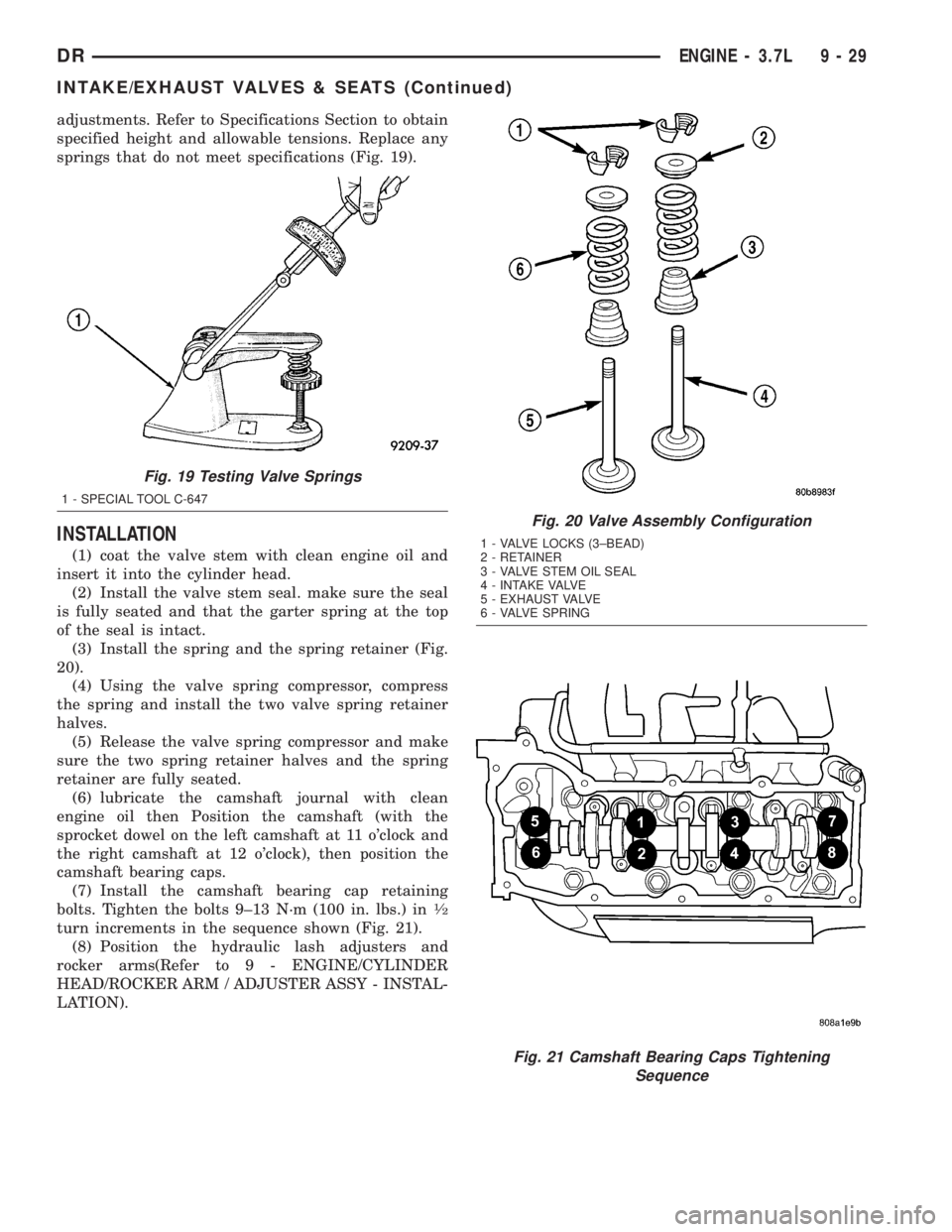
adjustments. Refer to Specifications Section to obtain
specified height and allowable tensions. Replace any
springs that do not meet specifications (Fig. 19).
INSTALLATION
(1) coat the valve stem with clean engine oil and
insert it into the cylinder head.
(2) Install the valve stem seal. make sure the seal
is fully seated and that the garter spring at the top
of the seal is intact.
(3) Install the spring and the spring retainer (Fig.
20).
(4) Using the valve spring compressor, compress
the spring and install the two valve spring retainer
halves.
(5) Release the valve spring compressor and make
sure the two spring retainer halves and the spring
retainer are fully seated.
(6) lubricate the camshaft journal with clean
engine oil then Position the camshaft (with the
sprocket dowel on the left camshaft at 11 o'clock and
the right camshaft at 12 o'clock), then position the
camshaft bearing caps.
(7) Install the camshaft bearing cap retaining
bolts. Tighten the bolts 9±13 N´m (100 in. lbs.) in
1¤2
turn increments in the sequence shown (Fig. 21).
(8) Position the hydraulic lash adjusters and
rocker arms(Refer to 9 - ENGINE/CYLINDER
HEAD/ROCKER ARM / ADJUSTER ASSY - INSTAL-
LATION).
Fig. 19 Testing Valve Springs
1 - SPECIAL TOOL C-647
Fig. 20 Valve Assembly Configuration
1 - VALVE LOCKS (3±BEAD)
2 - RETAINER
3 - VALVE STEM OIL SEAL
4 - INTAKE VALVE
5 - EXHAUST VALVE
6 - VALVE SPRING
Fig. 21 Camshaft Bearing Caps Tightening
Sequence
DRENGINE - 3.7L 9 - 29
INTAKE/EXHAUST VALVES & SEATS (Continued)
Page 1372 of 2895
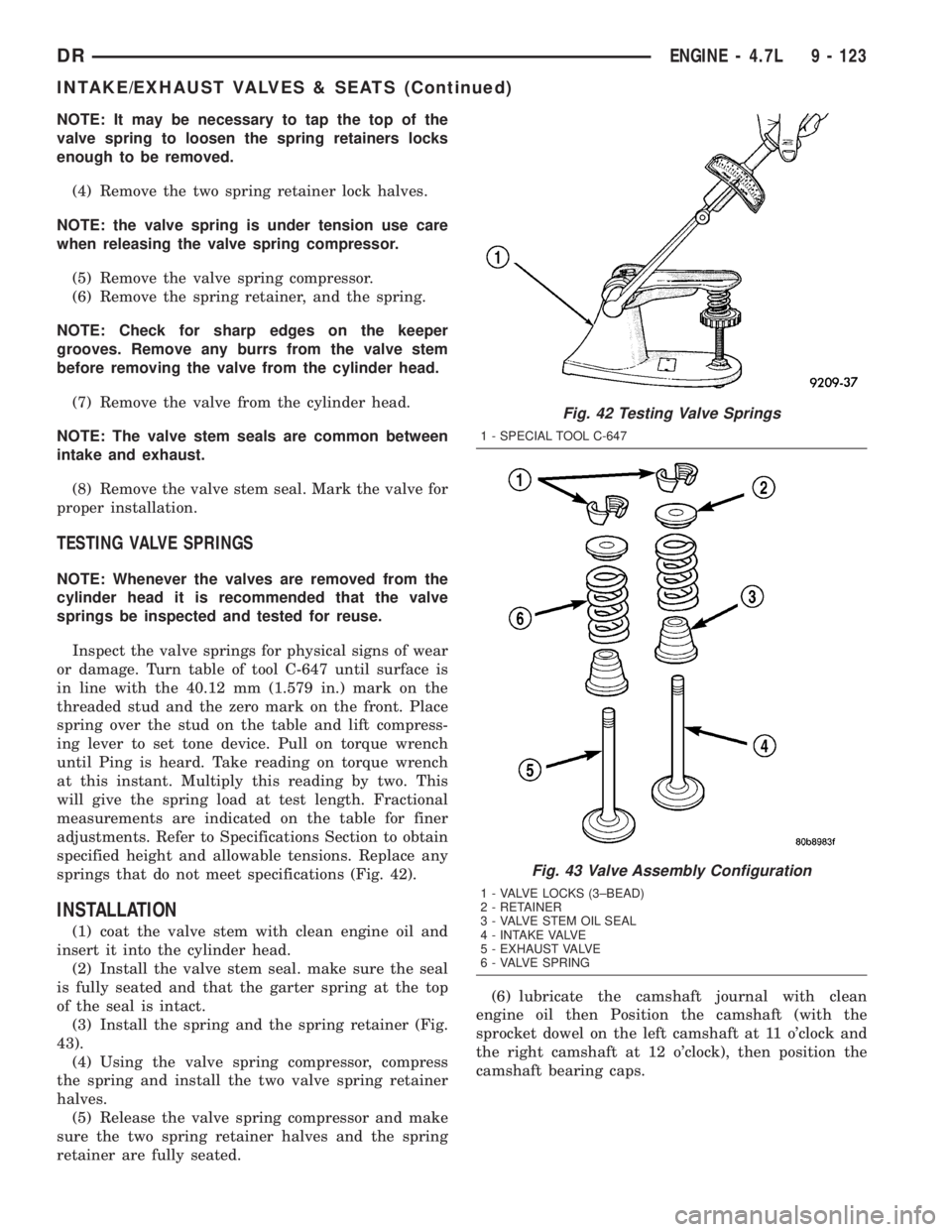
NOTE: It may be necessary to tap the top of the
valve spring to loosen the spring retainers locks
enough to be removed.
(4) Remove the two spring retainer lock halves.
NOTE: the valve spring is under tension use care
when releasing the valve spring compressor.
(5) Remove the valve spring compressor.
(6) Remove the spring retainer, and the spring.
NOTE: Check for sharp edges on the keeper
grooves. Remove any burrs from the valve stem
before removing the valve from the cylinder head.
(7) Remove the valve from the cylinder head.
NOTE: The valve stem seals are common between
intake and exhaust.
(8) Remove the valve stem seal. Mark the valve for
proper installation.
TESTING VALVE SPRINGS
NOTE: Whenever the valves are removed from the
cylinder head it is recommended that the valve
springs be inspected and tested for reuse.
Inspect the valve springs for physical signs of wear
or damage. Turn table of tool C-647 until surface is
in line with the 40.12 mm (1.579 in.) mark on the
threaded stud and the zero mark on the front. Place
spring over the stud on the table and lift compress-
ing lever to set tone device. Pull on torque wrench
until Ping is heard. Take reading on torque wrench
at this instant. Multiply this reading by two. This
will give the spring load at test length. Fractional
measurements are indicated on the table for finer
adjustments. Refer to Specifications Section to obtain
specified height and allowable tensions. Replace any
springs that do not meet specifications (Fig. 42).
INSTALLATION
(1) coat the valve stem with clean engine oil and
insert it into the cylinder head.
(2) Install the valve stem seal. make sure the seal
is fully seated and that the garter spring at the top
of the seal is intact.
(3) Install the spring and the spring retainer (Fig.
43).
(4) Using the valve spring compressor, compress
the spring and install the two valve spring retainer
halves.
(5) Release the valve spring compressor and make
sure the two spring retainer halves and the spring
retainer are fully seated.(6) lubricate the camshaft journal with clean
engine oil then Position the camshaft (with the
sprocket dowel on the left camshaft at 11 o'clock and
the right camshaft at 12 o'clock), then position the
camshaft bearing caps.
Fig. 42 Testing Valve Springs
1 - SPECIAL TOOL C-647
Fig. 43 Valve Assembly Configuration
1 - VALVE LOCKS (3±BEAD)
2 - RETAINER
3 - VALVE STEM OIL SEAL
4 - INTAKE VALVE
5 - EXHAUST VALVE
6 - VALVE SPRING
DRENGINE - 4.7L 9 - 123
INTAKE/EXHAUST VALVES & SEATS (Continued)
Page 1497 of 2895

ing stones. A true and complete surface must be
obtained.
(2) Measure the concentricity of valve seat using a
dial indicator. Total runout should not exceed 0.051
mm (0.002 in.) total indicator reading.
(3) Inspect the valve seat with Prussian blue, to
determine where the valve contacts the seat. To do
this, coat valve seat LIGHTLY with Prussian blue
then set valve in place. Rotate the valve with light
pressure. If the blue is transferred to the center of
valve face, contact is satisfactory. If the blue is trans-
ferred to the top edge of valve face, lower valve seat
with a 15É stone. If the blue is transferred to bottom
edge of valve face raise valve seat with a 60É stone.
(4) When seat is properly positioned the width of
intake seats should be 1.016-1.524 mm (0.040-0.060
in.). The width of the exhaust seats should be 1.524-
2.032 mm (0.060-0.080 in.).
VALVE SPRINGS
Whenever valves have been removed for inspection,
reconditioning or replacement, valve springs should
be tested. As an example the compression length of
the spring to be tested is 1-5/16 in.. Turn table of
Universal Valve Spring Tester Tool until surface is in
line with the 1-5/16 in. mark on the threaded stud.
Be sure the zero mark is to the front (Fig. 15). Place
spring over stud on the table and lift compressing
lever to set tone device. Pull on torque wrench until
ping is heard. Take reading on torque wrench at this
instant. Multiply this reading by 2. This will give the
spring load at test length. Fractional measurements
are indicated on the table for finer adjustments.
Refer to specifications to obtain specified height and
allowable tensions. Discard the springs that do not
meet specifications.
REMOVAL
(1) Remove the cylinder head (Refer to 9 -
ENGINE/CYLINDER HEAD - REMOVAL).
(2) Compress valve springs using Valve Spring
Compressor Tool MD- 998772A and adapter 6716A.
(3) Remove valve retaining locks, valve spring
retainers, valve stem seals and valve springs.
(4) Before removing valves, remove any burrs from
valve stem lock grooves to prevent damage to the
valve guides. Identify valves to ensure installation in
original location.
CLEANING
Clean valves thoroughly. Discard burned, warped,
or cracked valves.
Remove carbon and varnish deposits from inside of
valve guides with a reliable guide cleaner.
INSPECTION
Measure valve stems for wear. If wear exceeds
0.051 mm (0.002 in.), replace the valve.
Measure valve stem guide clearance as follows:
(1) Install Valve Guide Sleeve Tool C-3973 over
valve stem and install valve (Fig. 16). The special
sleeve places the valve at the correct height for
checking with a dial indicator.
(2) Attach dial indicator Tool C-3339 to cylinder
head and set it at right angles to valve stem being
measured (Fig. 17).
(3) Move valve to and from the indicator. The total
dial indicator reading should not exceed 0.432 mm
(0.017 in.). Ream the guides for valves with oversize
stems if dial indicator reading is excessive or if the
stems are scuffed or scored.
INSTALLATION
(1) Clean valves thoroughly. Discard burned,
warped and cracked valves.
(2) Remove carbon and varnish deposits from
inside of valve guides with a reliable guide cleaner.Fig. 15 Testing Valve Spring for Compressed
Length
1 - TORQUE WRENCH
2 - VALVE SPRING TESTER
Fig. 16 Positioning Valve with Tool C-3973
1 - VALVE
2 - SPACER TOOL
9 - 248 ENGINE - 5.9LDR
INTAKE/EXHAUST VALVES & SEATS (Continued)
Page 1625 of 2895
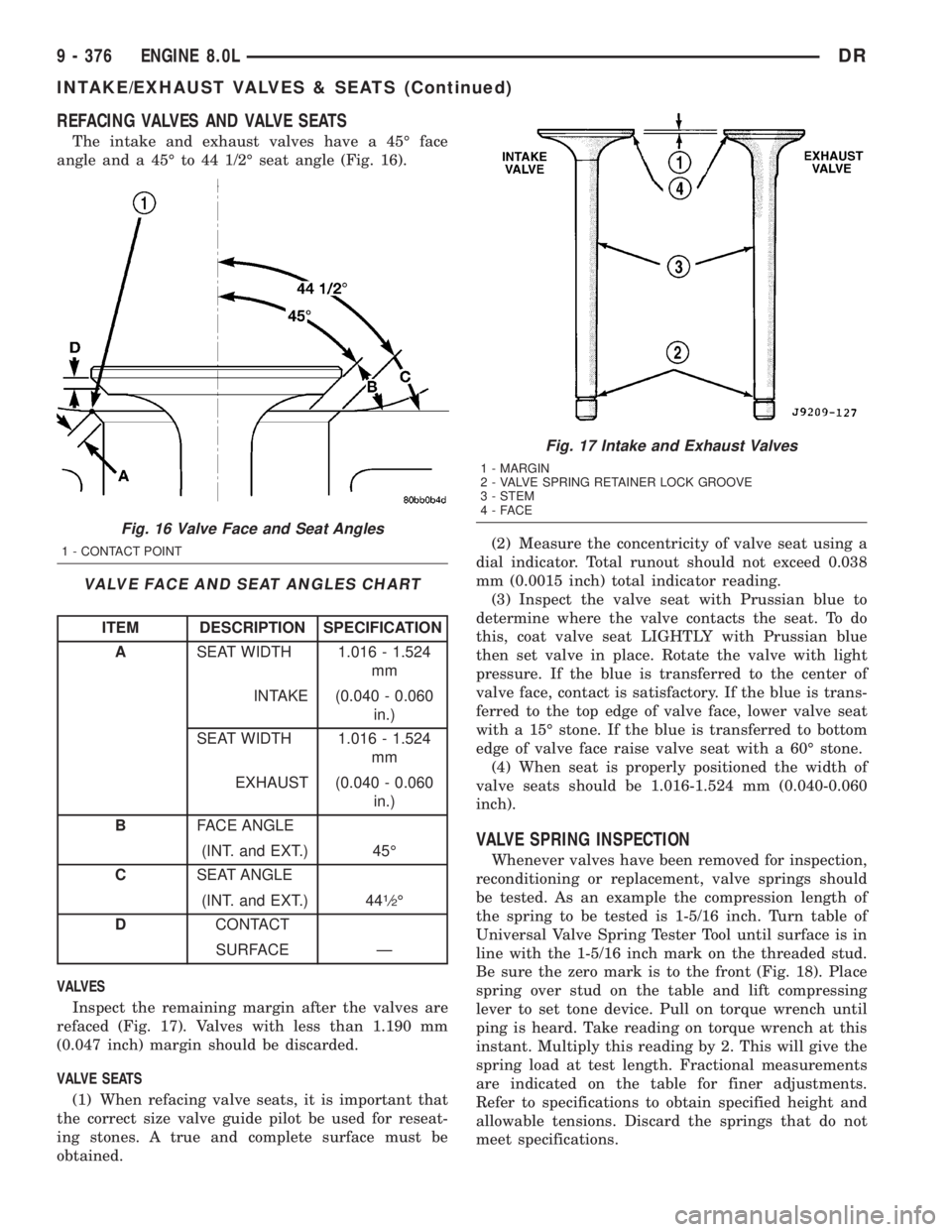
REFACING VALVES AND VALVE SEATS
The intake and exhaust valves have a 45É face
angle and a 45É to 44 1/2É seat angle (Fig. 16).
VALVE FACE AND SEAT ANGLES CHART
ITEM DESCRIPTION SPECIFICATION
ASEAT WIDTH 1.016 - 1.524
mm
INTAKE (0.040 - 0.060
in.)
SEAT WIDTH 1.016 - 1.524
mm
EXHAUST (0.040 - 0.060
in.)
BFACE ANGLE
(INT. and EXT.) 45É
CSEAT ANGLE
(INT. and EXT.) 44
1¤2É
DCONTACT
SURFACE Ð
VALVES
Inspect the remaining margin after the valves are
refaced (Fig. 17). Valves with less than 1.190 mm
(0.047 inch) margin should be discarded.
VALVE SEATS
(1) When refacing valve seats, it is important that
the correct size valve guide pilot be used for reseat-
ing stones. A true and complete surface must be
obtained.(2) Measure the concentricity of valve seat using a
dial indicator. Total runout should not exceed 0.038
mm (0.0015 inch) total indicator reading.
(3) Inspect the valve seat with Prussian blue to
determine where the valve contacts the seat. To do
this, coat valve seat LIGHTLY with Prussian blue
then set valve in place. Rotate the valve with light
pressure. If the blue is transferred to the center of
valve face, contact is satisfactory. If the blue is trans-
ferred to the top edge of valve face, lower valve seat
with a 15É stone. If the blue is transferred to bottom
edge of valve face raise valve seat with a 60É stone.
(4) When seat is properly positioned the width of
valve seats should be 1.016-1.524 mm (0.040-0.060
inch).
VALVE SPRING INSPECTION
Whenever valves have been removed for inspection,
reconditioning or replacement, valve springs should
be tested. As an example the compression length of
the spring to be tested is 1-5/16 inch. Turn table of
Universal Valve Spring Tester Tool until surface is in
line with the 1-5/16 inch mark on the threaded stud.
Be sure the zero mark is to the front (Fig. 18). Place
spring over stud on the table and lift compressing
lever to set tone device. Pull on torque wrench until
ping is heard. Take reading on torque wrench at this
instant. Multiply this reading by 2. This will give the
spring load at test length. Fractional measurements
are indicated on the table for finer adjustments.
Refer to specifications to obtain specified height and
allowable tensions. Discard the springs that do not
meet specifications.
Fig. 16 Valve Face and Seat Angles
1 - CONTACT POINT
Fig. 17 Intake and Exhaust Valves
1 - MARGIN
2 - VALVE SPRING RETAINER LOCK GROOVE
3 - STEM
4-FACE
9 - 376 ENGINE 8.0LDR
INTAKE/EXHAUST VALVES & SEATS (Continued)
Page 1866 of 2895
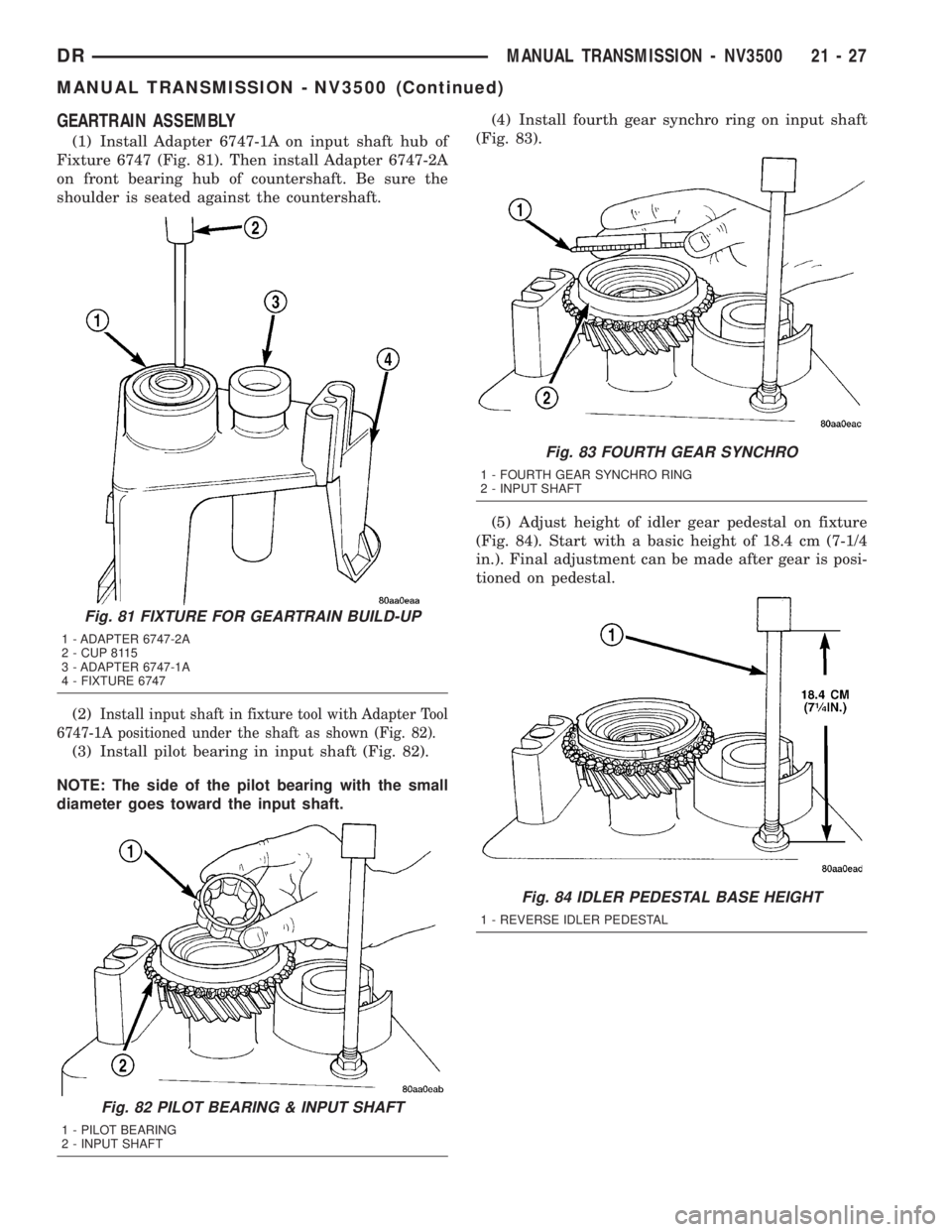
GEARTRAIN ASSEMBLY
(1) Install Adapter 6747-1A on input shaft hub of
Fixture 6747 (Fig. 81). Then install Adapter 6747-2A
on front bearing hub of countershaft. Be sure the
shoulder is seated against the countershaft.
(2)
Install input shaft in fixture tool with Adapter Tool
6747-1A positioned under the shaft as shown (Fig. 82).
(3) Install pilot bearing in input shaft (Fig. 82).
NOTE: The side of the pilot bearing with the small
diameter goes toward the input shaft.(4) Install fourth gear synchro ring on input shaft
(Fig. 83).
(5) Adjust height of idler gear pedestal on fixture
(Fig. 84). Start with a basic height of 18.4 cm (7-1/4
in.). Final adjustment can be made after gear is posi-
tioned on pedestal.
Fig. 81 FIXTURE FOR GEARTRAIN BUILD-UP
1 - ADAPTER 6747-2A
2 - CUP 8115
3 - ADAPTER 6747-1A
4 - FIXTURE 6747
Fig. 82 PILOT BEARING & INPUT SHAFT
1 - PILOT BEARING
2 - INPUT SHAFT
Fig. 83 FOURTH GEAR SYNCHRO
1 - FOURTH GEAR SYNCHRO RING
2 - INPUT SHAFT
Fig. 84 IDLER PEDESTAL BASE HEIGHT
1 - REVERSE IDLER PEDESTAL
DRMANUAL TRANSMISSION - NV3500 21 - 27
MANUAL TRANSMISSION - NV3500 (Continued)
Page 2871 of 2895
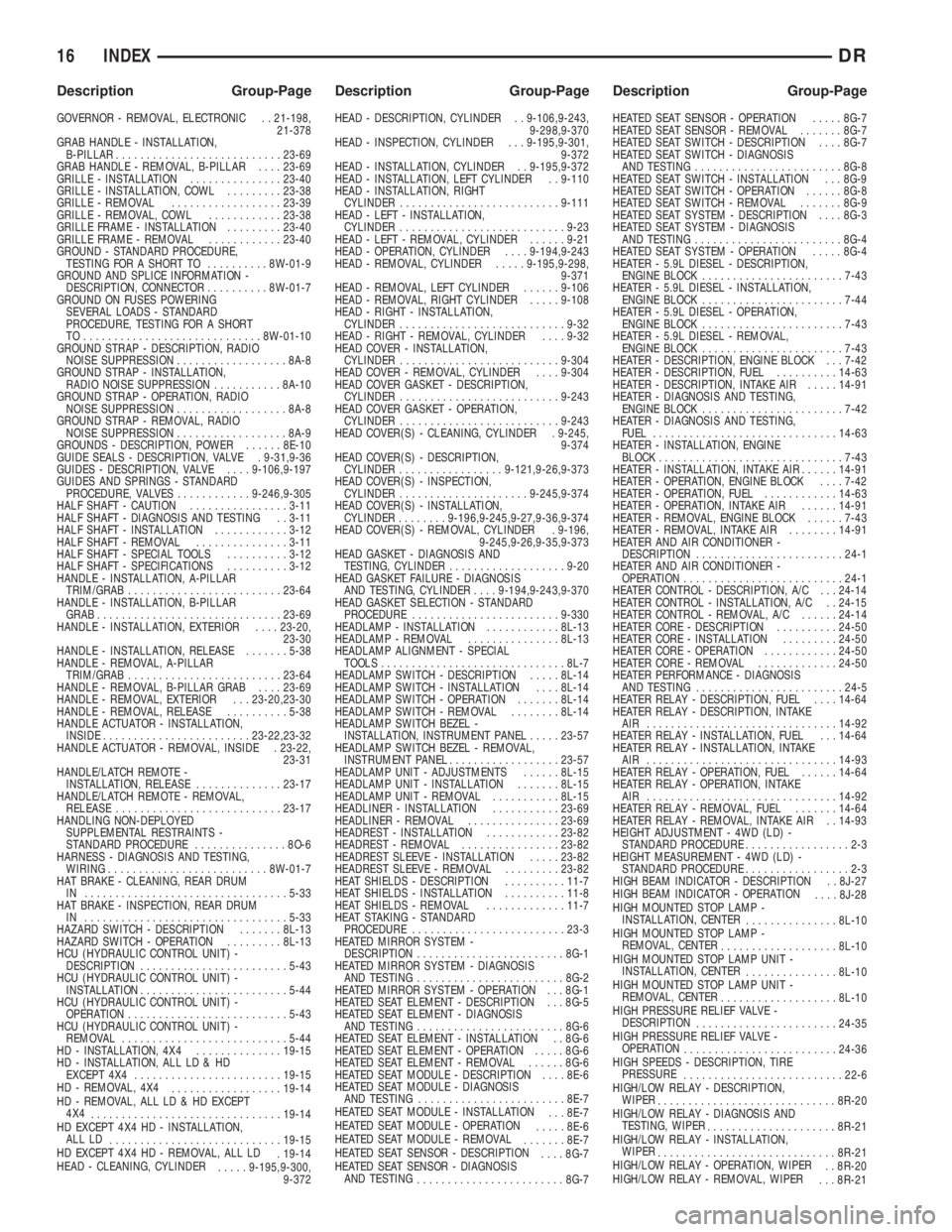
GOVERNOR - REMOVAL, ELECTRONIC . . 21-198,
21-378
GRAB HANDLE - INSTALLATION,
B-PILLAR...........................23-69
GRAB HANDLE - REMOVAL, B-PILLAR....23-69
GRILLE - INSTALLATION...............23-40
GRILLE - INSTALLATION, COWL.........23-38
GRILLE - REMOVAL..................23-39
GRILLE - REMOVAL, COWL............23-38
GRILLE FRAME - INSTALLATION.........23-40
GRILLE FRAME - REMOVAL............23-40
GROUND - STANDARD PROCEDURE,
TESTING FOR A SHORT TO..........8W-01-9
GROUND AND SPLICE INFORMATION -
DESCRIPTION, CONNECTOR..........8W-01-7
GROUND ON FUSES POWERING
SEVERAL LOADS - STANDARD
PROCEDURE, TESTING FOR A SHORT
TO.............................8W-01-10
GROUND STRAP - DESCRIPTION, RADIO
NOISE SUPPRESSION..................8A-8
GROUND STRAP - INSTALLATION,
RADIO NOISE SUPPRESSION...........8A-10
GROUND STRAP - OPERATION, RADIO
NOISE SUPPRESSION..................8A-8
GROUND STRAP - REMOVAL, RADIO
NOISE SUPPRESSION..................8A-9
GROUNDS - DESCRIPTION, POWER......8E-10
GUIDE SEALS - DESCRIPTION, VALVE . 9-31,9-36
GUIDES - DESCRIPTION, VALVE....9-106,9-197
GUIDES AND SPRINGS - STANDARD
PROCEDURE, VALVES............9-246,9-305
HALF SHAFT - CAUTION................3-11
HALF SHAFT - DIAGNOSIS AND TESTING . . 3-11
HALF SHAFT - INSTALLATION............3-12
HALF SHAFT - REMOVAL...............3-11
HALF SHAFT - SPECIAL TOOLS..........3-12
HALF SHAFT - SPECIFICATIONS..........3-12
HANDLE - INSTALLATION, A-PILLAR
TRIM/GRAB.........................23-64
HANDLE - INSTALLATION, B-PILLAR
GRAB..............................23-69
HANDLE - INSTALLATION, EXTERIOR....23-20,
23-30
HANDLE - INSTALLATION, RELEASE.......5-38
HANDLE - REMOVAL, A-PILLAR
TRIM/GRAB.........................23-64
HANDLE - REMOVAL, B-PILLAR GRAB....23-69
HANDLE - REMOVAL, EXTERIOR . . . 23-20,23-30
HANDLE - REMOVAL, RELEASE..........5-38
HANDLE ACTUATOR - INSTALLATION,
INSIDE........................23-22,23-32
HANDLE ACTUATOR - REMOVAL, INSIDE . 23-22,
23-31
HANDLE/LATCH REMOTE -
INSTALLATION, RELEASE..............23-17
HANDLE/LATCH REMOTE - REMOVAL,
RELEASE...........................23-17
HANDLING NON-DEPLOYED
SUPPLEMENTAL RESTRAINTS -
STANDARD PROCEDURE...............8O-6
HARNESS - DIAGNOSIS AND TESTING,
WIRING..........................8W-01-7
HAT BRAKE - CLEANING, REAR DRUM
IN .................................5-33
HAT BRAKE - INSPECTION, REAR DRUM
IN .................................5-33
HAZARD SWITCH - DESCRIPTION.......8L-13
HAZARD SWITCH - OPERATION.........8L-13
HCU (HYDRAULIC CONTROL UNIT) -
DESCRIPTION........................5-43
HCU (HYDRAULIC CONTROL UNIT) -
INSTALLATION........................5-44
HCU (HYDRAULIC CONTROL UNIT) -
OPERATION..........................5-43
HCU (HYDRAULIC CONTROL UNIT) -
REMOVAL...........................5-44
HD - INSTALLATION, 4X4..............19-15
HD - INSTALLATION, ALL LD & HD
EXCEPT 4X4........................19-15
HD - REMOVAL, 4X4
..................19-14
HD - REMOVAL, ALL LD & HD EXCEPT
4X4
...............................19-14
HD EXCEPT 4X4 HD - INSTALLATION,
ALL LD
............................19-15
HD EXCEPT 4X4 HD - REMOVAL, ALL LD
. 19-14
HEAD - CLEANING, CYLINDER
.....9-195,9-300,
9-372HEAD - DESCRIPTION, CYLINDER . . 9-106,9-243,
9-298,9-370
HEAD - INSPECTION, CYLINDER . . . 9-195,9-301,
9-372
HEAD - INSTALLATION, CYLINDER . . 9-195,9-372
HEAD - INSTALLATION, LEFT CYLINDER . . 9-110
HEAD - INSTALLATION, RIGHT
CYLINDER..........................9-111
HEAD - LEFT - INSTALLATION,
CYLINDER...........................9-23
HEAD - LEFT - REMOVAL, CYLINDER......9-21
HEAD - OPERATION, CYLINDER....9-194,9-243
HEAD - REMOVAL, CYLINDER.....9-195,9-298,
9-371
HEAD - REMOVAL, LEFT CYLINDER......9-106
HEAD - REMOVAL, RIGHT CYLINDER.....9-108
HEAD - RIGHT - INSTALLATION,
CYLINDER...........................9-32
HEAD - RIGHT - REMOVAL, CYLINDER....9-32
HEAD COVER - INSTALLATION,
CYLINDER..........................9-304
HEAD COVER - REMOVAL, CYLINDER....9-304
HEAD COVER GASKET - DESCRIPTION,
CYLINDER..........................9-243
HEAD COVER GASKET - OPERATION,
CYLINDER..........................9-243
HEAD COVER(S) - CLEANING, CYLINDER . 9-245,
9-374
HEAD COVER(S) - DESCRIPTION,
CYLINDER.................9-121,9-26,9-373
HEAD COVER(S) - INSPECTION,
CYLINDER.....................9-245,9-374
HEAD COVER(S) - INSTALLATION,
CYLINDER........9-196,9-245,9-27,9-36,9-374
HEAD COVER(S) - REMOVAL, CYLINDER . 9-196,
9-245,9-26,9-35,9-373
HEAD GASKET - DIAGNOSIS AND
TESTING, CYLINDER...................9-20
HEAD GASKET FAILURE - DIAGNOSIS
AND TESTING, CYLINDER....9-194,9-243,9-370
HEAD GASKET SELECTION - STANDARD
PROCEDURE........................9-330
HEADLAMP - INSTALLATION............8L-13
HEADLAMP - REMOVAL...............8L-13
HEADLAMP ALIGNMENT - SPECIAL
TOOLS..............................8L-7
HEADLAMP SWITCH - DESCRIPTION.....8L-14
HEADLAMP SWITCH - INSTALLATION....8L-14
HEADLAMP SWITCH - OPERATION.......8L-14
HEADLAMP SWITCH - REMOVAL........8L-14
HEADLAMP SWITCH BEZEL -
INSTALLATION, INSTRUMENT PANEL.....23-57
HEADLAMP SWITCH BEZEL - REMOVAL,
INSTRUMENT PANEL..................23-57
HEADLAMP UNIT - ADJUSTMENTS......8L-15
HEADLAMP UNIT - INSTALLATION.......8L-15
HEADLAMP UNIT - REMOVAL...........8L-15
HEADLINER - INSTALLATION...........23-69
HEADLINER - REMOVAL...............23-69
HEADREST - INSTALLATION............23-82
HEADREST - REMOVAL................23-82
HEADREST SLEEVE - INSTALLATION.....23-82
HEADREST SLEEVE - REMOVAL.........23-82
HEAT SHIELDS - DESCRIPTION..........11-7
HEAT SHIELDS - INSTALLATION..........11-8
HEAT SHIELDS - REMOVAL.............11-7
HEAT STAKING - STANDARD
PROCEDURE.........................23-3
HEATED MIRROR SYSTEM -
DESCRIPTION........................8G-1
HEATED MIRROR SYSTEM - DIAGNOSIS
AND TESTING........................8G-2
HEATED MIRROR SYSTEM - OPERATION . . . 8G-1
HEATED SEAT ELEMENT - DESCRIPTION . . . 8G-5
HEATED SEAT ELEMENT - DIAGNOSIS
AND TESTING........................8G-6
HEATED SEAT ELEMENT - INSTALLATION . . 8G-6
HEATED SEAT ELEMENT - OPERATION.....8G-6
HEATED SEAT ELEMENT - REMOVAL......8G-6
HEATED SEAT MODULE - DESCRIPTION....8E-6
HEATED SEAT MODULE - DIAGNOSIS
AND TESTING........................8E-7
HEATED SEAT MODULE - INSTALLATION
. . . 8E-7
HEATED SEAT MODULE - OPERATION
.....8E-6
HEATED SEAT MODULE - REMOVAL
.......8E-7
HEATED SEAT SENSOR - DESCRIPTION
....8G-7
HEATED SEAT SENSOR - DIAGNOSIS
AND TESTING
........................8G-7HEATED SEAT SENSOR - OPERATION.....8G-7
HEATED SEAT SENSOR - REMOVAL.......8G-7
HEATED SEAT SWITCH - DESCRIPTION....8G-7
HEATED SEAT SWITCH - DIAGNOSIS
AND TESTING........................8G-8
HEATED SEAT SWITCH - INSTALLATION . . . 8G-9
HEATED SEAT SWITCH - OPERATION......8G-8
HEATED SEAT SWITCH - REMOVAL.......8G-9
HEATED SEAT SYSTEM - DESCRIPTION....8G-3
HEATED SEAT SYSTEM - DIAGNOSIS
AND TESTING........................8G-4
HEATED SEAT SYSTEM - OPERATION.....8G-4
HEATER - 5.9L DIESEL - DESCRIPTION,
ENGINE BLOCK.......................7-43
HEATER - 5.9L DIESEL - INSTALLATION,
ENGINE BLOCK.......................7-44
HEATER - 5.9L DIESEL - OPERATION,
ENGINE BLOCK.......................7-43
HEATER - 5.9L DIESEL - REMOVAL,
ENGINE BLOCK.......................7-43
HEATER - DESCRIPTION, ENGINE BLOCK . . . 7-42
HEATER - DESCRIPTION, FUEL..........14-63
HEATER - DESCRIPTION, INTAKE AIR.....14-91
HEATER - DIAGNOSIS AND TESTING,
ENGINE BLOCK.......................7-42
HEATER - DIAGNOSIS AND TESTING,
FUEL..............................14-63
HEATER - INSTALLATION, ENGINE
BLOCK..............................7-43
HEATER - INSTALLATION, INTAKE AIR......14-91
HEATER - OPERATION, ENGINE BLOCK....7-42
HEATER - OPERATION, FUEL............14-63
HEATER - OPERATION, INTAKE AIR......14-91
HEATER - REMOVAL, ENGINE BLOCK......7-43
HEATER - REMOVAL, INTAKE AIR........14-91
HEATER AND AIR CONDITIONER -
DESCRIPTION........................24-1
HEATER AND AIR CONDITIONER -
OPERATION..........................24-1
HEATER CONTROL - DESCRIPTION, A/C . . . 24-14
HEATER CONTROL - INSTALLATION, A/C . . 24-15
HEATER CONTROL - REMOVAL, A/C......24-14
HEATER CORE - DESCRIPTION..........24-50
HEATER CORE - INSTALLATION.........24-50
HEATER CORE - OPERATION............24-50
HEATER CORE - REMOVAL.............24-50
HEATER PERFORMANCE - DIAGNOSIS
AND TESTING........................24-5
HEATER RELAY - DESCRIPTION, FUEL....14-64
HEATER RELAY - DESCRIPTION, INTAKE
AIR ...............................14-92
HEATER RELAY - INSTALLATION, FUEL . . . 14-64
HEATER RELAY - INSTALLATION, INTAKE
AIR ...............................14-93
HEATER RELAY - OPERATION, FUEL......14-64
HEATER RELAY - OPERATION, INTAKE
AIR ...............................14-92
HEATER RELAY - REMOVAL, FUEL.......14-64
HEATER RELAY - REMOVAL, INTAKE AIR . . 14-93
HEIGHT ADJUSTMENT - 4WD (LD) -
STANDARD PROCEDURE.................2-3
HEIGHT MEASUREMENT - 4WD (LD) -
STANDARD PROCEDURE.................2-3
HIGH BEAM INDICATOR - DESCRIPTION . . 8J-27
HIGH BEAM INDICATOR - OPERATION
....8J-28
HIGH MOUNTED STOP LAMP -
INSTALLATION, CENTER
...............8L-10
HIGH MOUNTED STOP LAMP -
REMOVAL, CENTER
...................8L-10
HIGH MOUNTED STOP LAMP UNIT -
INSTALLATION, CENTER
...............8L-10
HIGH MOUNTED STOP LAMP UNIT -
REMOVAL, CENTER
...................8L-10
HIGH PRESSURE RELIEF VALVE -
DESCRIPTION
.......................24-35
HIGH PRESSURE RELIEF VALVE -
OPERATION
.........................24-36
HIGH SPEEDS - DESCRIPTION, TIRE
PRESSURE
..........................22-6
HIGH/LOW RELAY - DESCRIPTION,
WIPER
.............................8R-20
HIGH/LOW RELAY - DIAGNOSIS AND
TESTING, WIPER
.....................8R-21
HIGH/LOW RELAY - INSTALLATION,
WIPER
.............................8R-21
HIGH/LOW RELAY - OPERATION, WIPER
. . 8R-20
HIGH/LOW RELAY - REMOVAL, WIPER
. . . 8R-21
16 INDEXDR
Description Group-Page Description Group-Page Description Group-Page